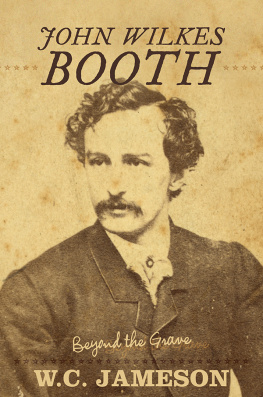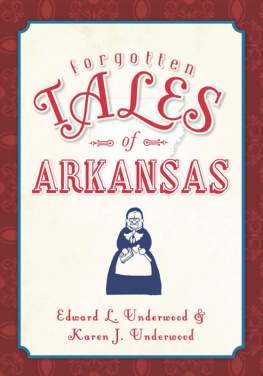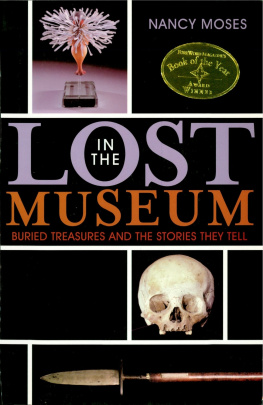W.C. JAMESON
Goldminds Publishing, LLC.
1050 Glenbrook Way, Suite 480
Hendersonville, TN 37075
Lost Mines and Buried Treasures
of Arkansas
Copyright W.C. Jameson,
October 2011.
Cover photo copyright
Ron McGinnis,
www.ronmcginnis.com
Author photo copyright Joe Smith
Printed in the United States of America. Without limiting the rights under the copyright reserved above, no part of this publication may be reproduced, stored in or introduced into a retrieval system, or transmitted, in any form or by any means, electronic, mechanical, photocopying, recording or otherwise, without the prior written permission of both the copyright owner and the above publisher of this book. www.goldmindspub.com
Introduction
Arkansas is a land rich in history, folklore, and legend. Located at the far western edge of the American South, the state offers environmental contrasts ranging from low, gentle mountain ranges in the northern and western parts of the state to flat deltaic deposits rich with agricultural products in the east and southeast.
Though ranked among the economically poorest of the United States, Arkansas is rich in other ways. The scenic Ozark and Ouachita Mountains attract vacationers from around the rest of the country who come to enjoy the beauty of the hills and hollows, the lakes and rivers, and the forests and wildlife. Arkansas state parks take a back seat to few other states, and are a preferred summertime destination for many.
Culturally, Arkansas has been home to several tribes of Indians, early Spanish explorers, and French trappers and traders. The population growth of the Natural State got underway with the immigration to the area of people from the Upper and Lower South, many of whom were escaping the after-effects of the Civil War. Early population growth was slow but steady, eventually giving rise to important settlements such as Little Rock, Jonesboro, Fort Smith, and others.
The newcomers to the state brought with them their cultural heritage which often included not only religion and language, but music, food preferences, and storytelling. Indeed, storytelling grew to be a rich tradition throughout much of the region over time.
The tales and the oft-repeated legends were characterized by their colorful presentations, often accompanied by music and acting. In this oral tradition, many stories were handed down over the generations. These included wisdom and advice relative to treating illnesses, to planting and harvesting, and some related to hunting and fishing. There were stories of ghosts, spirits, and monsters believed to be residing in the hills and valleys and which still frightened residents and travelers alike.
And there were numerous of tales of lost mines and buried treasures. Many of these stories were passed down via family and friends; others were part of the historical record. In all, they comprise a remarkable collection of numerous quests for wealth and fortune. Over the years, some of these lost mines and buried treasures were found, but many more remain hidden, awaiting a lucky searcher.
Most of the accounts included in this book are the result of a different kind of treasure hunt. Long fascinated by the lure of hidden wealth, I spent countless hours driving Arkansas back roads and trails in search of the stories. For hours, I sat at tables and desks in small county libraries poring over old journals, diaries, and historical society newsletters, reading archival material written by or about early residents. There followed dozens of interviews with people who knew the stories. I enjoyed sharing with others who were likewise interested in and captivated by such things.
And then I engaged in actual hunts for lost treasures, mines, and caches. Following cryptic directions discovered between the pages of an old book found in an antique store or tracing the route marked on a parchment map I covered hundreds of miles of backcountry Arkansas by truck and on foot. In some cases, the experience of the search verified much of what I heard in the stories. In other cases, it led to my own special adventures.
Over the years, the collection grew. There were articles, books, even television and film appearances relative to the lost mines and buried treasures. The more I pursued the tales and legends, the more people contacted me and provided me with more.
People often ask: Did you find any of the lost mines, the caches? Indeed I did, but that is another book. This one is about the treasures that are still there. These stories are alive with potential, with the thrill of the quest. These are the stories that continue to lure the hopeful adventurer across the state in search of treasure. It is there, waiting to be found.
The Madre Vena Treasure Cache
One of the most celebrated lost treasures in the state of Arkansas is the one known as the Madre Vena Treasure Cache. It is also among the most elusive. Men have searched for generations, yet no one has found it. That it exists is not open to question, for its existence, and its location have been documented. The difficulty has been associated with the recovery process.
The Madre Vena Treasure has often been referred to as a lost gold mine. The truth is, it is not a mine at all, but rather a natural cavern in which tons of gold and silver ore were hidden over a century-and-a-half ago. The cavern is located somewhere deep in the Ozark Mountains. Inside reputedly lies a fortune that could make many men as rich as Croesus.
Legends and tales of early Spanish explorers finding and mining gold and silver from the Ozark Mountains are many. In recent years, a number of so-called experts have stated that neither gold nor silver can be found in these mountains, explaining that they are composed of sedi-mentary rock which, in turn, has never yielded such metals.
Those who claimed to be experts are wrong. The truth is, gold and silver have been mined in the Ozark and Ouachita ranges in historical and contemporary times. A simple reading of historical and extant mining records verifies this. Furthermore, granite, the rock that is conducive to housing deposits of gold and silver underlies both of these ranges, manifests great exposures and outcrops all across the region. In fact, in 1998, Arkansas American Mining and Exploration, Inc. announced the gold discovery of the century at a location in the Ouachita Mountains.
During the peak of Spanish exploration and mining in the Ozarks, quantities of both gold and silver were taken from the ground, loaded onto burros, and transported toward the southeast. Armed soldiers would escort these pack trains to destinations such as New Orleans or the Florida coast where the ore would be loaded onto Spanish vessels. These ships would make the long trans-Atlantic voyage to Spain where the ore would be converted to coins and ingots and deposited in that countrys treasury. The wealth was used to run the government and finance the many wars throughout Europe and elsewhere that Spain was engaged in during that time. It was further employed to sustain many of Spains possessions













